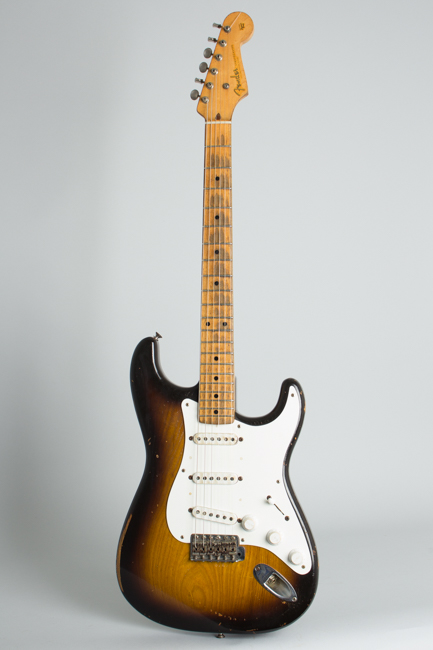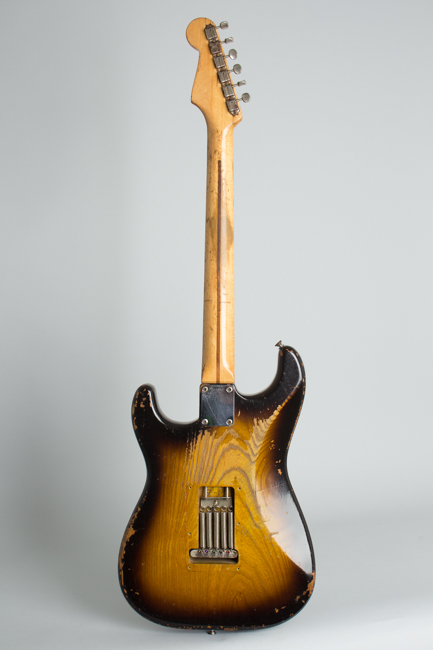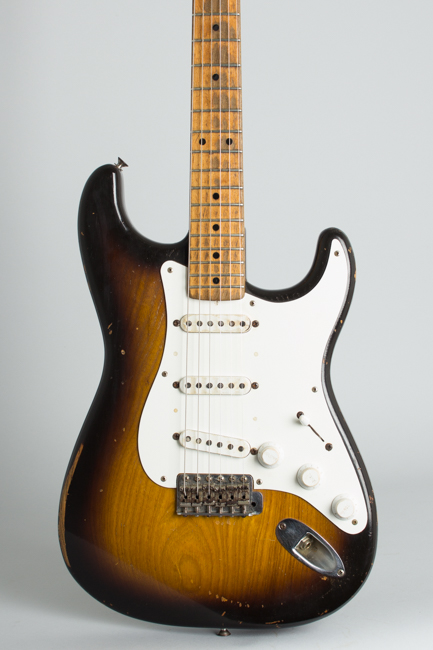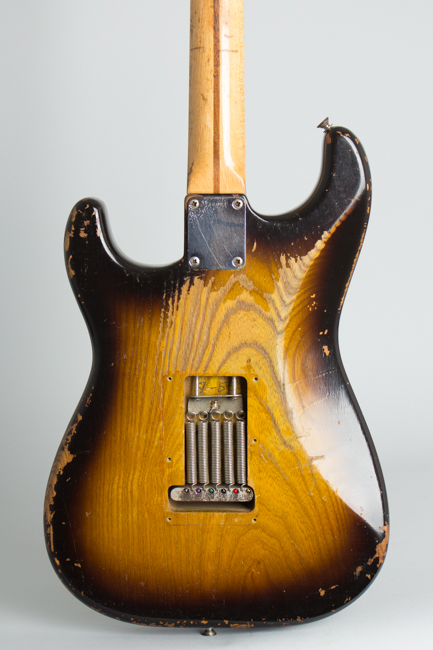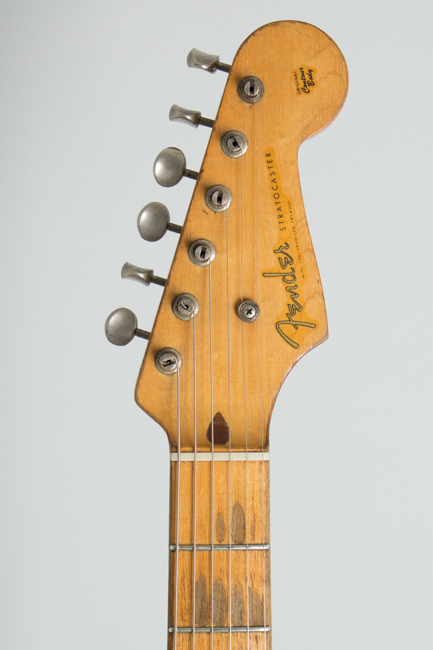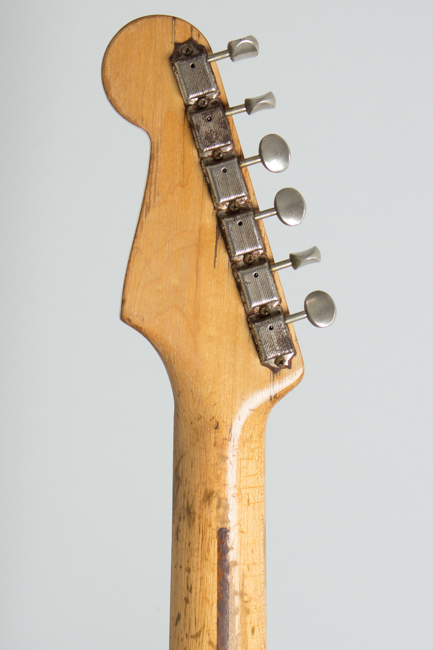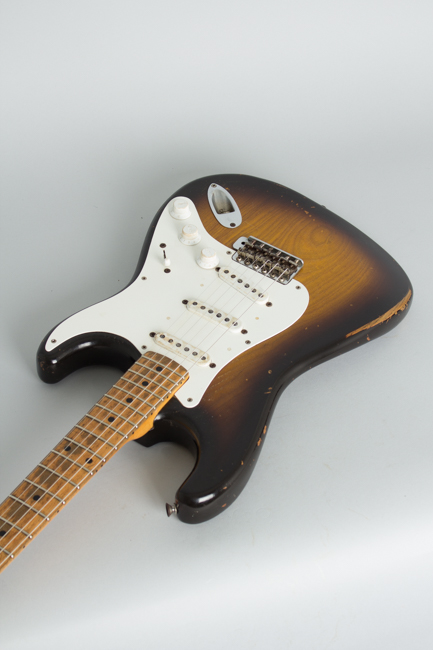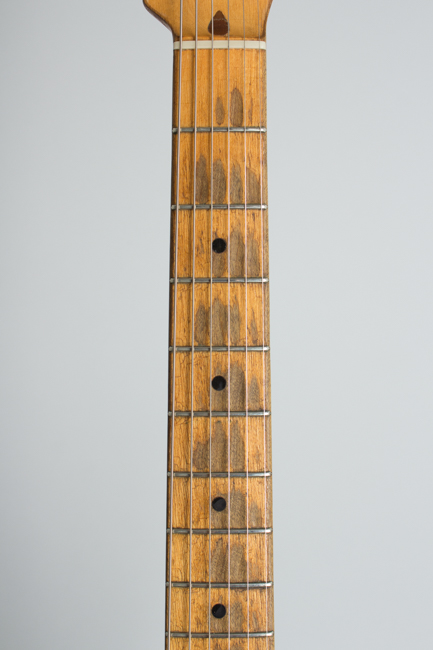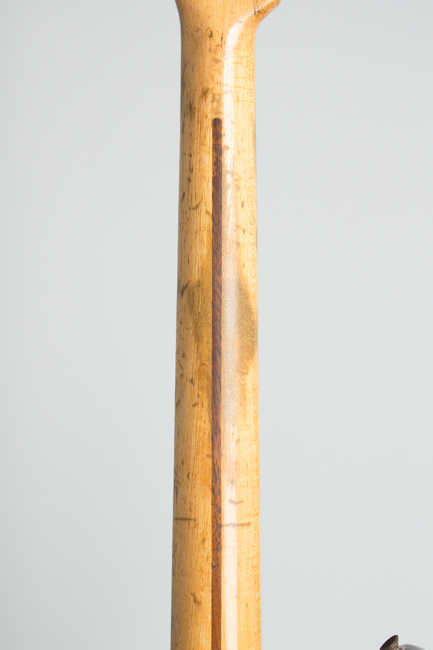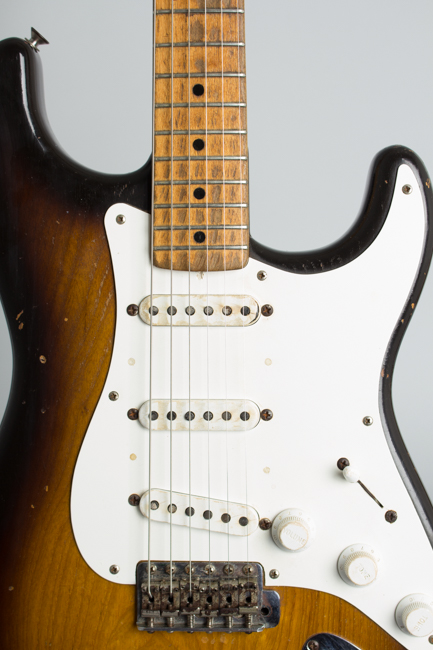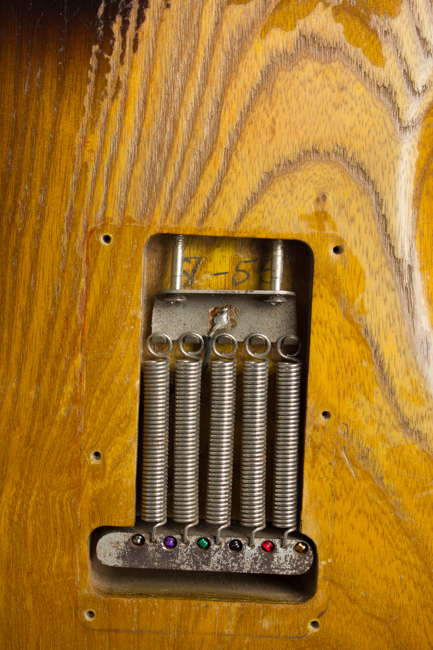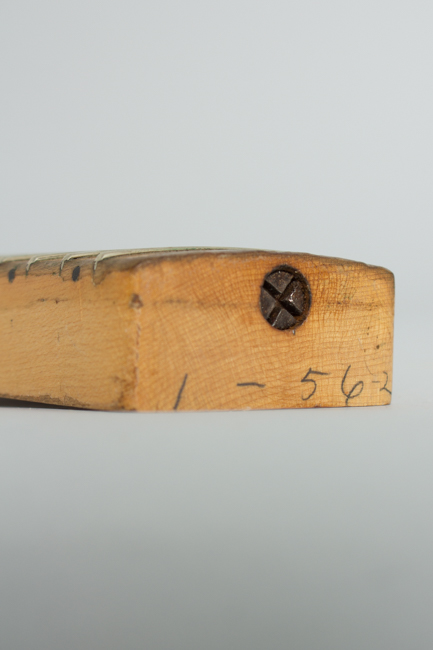Fender Stratocaster Solid Body Electric Guitar (1956)
This item has been sold.
Item # 8775
Prices subject to change without notice.
Fender Stratocaster Model Solid Body Electric Guitar (1956), made in Fullerton, California, serial # 10093, two tone sunburst lacquer finish, ash body, maple neck, gig bag case.
This is a beautifully weathered example of an early Fender Stratocaster, probably the single most influential electric guitar ever designed. Dated on the neck "1-56" and on the body "8-55", this guitar was assembled just over a year a year after the beginning of full production of this model in October 1954. The visible pot date is the 33rd week of 1955. The assembler's name is signed on a piece of masking tape in the cavity; it appears to be "Christina", but the date is too faded to make out clearly.
While technically a 1956 guitar, this Stratocaster still carries many of the first-generation features of the model from 1954-55. This includes the early hard plastic pickup covers and knobs called "Bakelite" in the vernacular, although that is not really what they are made of.
These first Stratocasters left the Fullerton, California factory in relatively small numbers. At a time when other electric guitars were fairly conservative-looking, this instrument must have looked like it just arrived from the Stratosphere indeed! As standard for the mid-'50s, this guitar features a beautifully grained contoured one-piece ash body with the original deep 2-tone sunburst finish. The one-piece maple neck has a round backed "C" profile with just the slightest hint of a dressed-away shoulder from the first to fifth frets. The round string tree on headstock, Kluson Deluxe tuners with no name on the casings, and the old style "Spaghetti" logo decal are all unchanged from 1954.
This guitar plays very well and sounds spectacular, with some truly transcendent "in between" switch sounds -- it absolutely nails the early-'70s Richard Thompson sound. While '50s Stratocasters have been re-issued and "relic-ed" endlessly over the last decades, none have really reproduced an intangible magic found in these early Fenders. While not a perfect example, this is a wonderful instrument nonetheless, a reminder of why and where "vintage" guitar culture emerged in the first place.
Overall length is 38.25 in. (97.2 cm.), 12.5 in. (31.8 cm.) wide at lower bout, and 1.75 in. (4.4 cm.) deep. Scale length is 25 1/2 in. (648 mm.). Width of nut is 1 5/8 in. (41 mm.).
This guitar remains in well-worn but largely original condition; early Stratocasters are particularly prone to parts substitutions or modifications, as some of the original plastic is more fragile than later incarnations. This guitar does have a couple of anomalies that are hard to explain absolutely but are not unheard of either.
Although the electronics are all period correct and appear original to the guitar, internally there is some additional minor routing to the cavities, slightly lengthening all three pickup routs on the bass side and the control rout on the treble. There is a very thin coat of what appears to be the original dark color coat paint from the sunbursting process applied over the routs and lacquer clear coat, as would indeed be the case if a final assembler was having trouble fitting the pickguard down to the guitar and resorted to opening them up just a bit. This sort of "assembly line" finagle to the body is not unknown, especially on some other makers' guitars, but is uncommon on early Fenders. We can't absolutely state this was factory work, but it looks consistent to the period anyway.
Outside of this quizzical anomaly the guitar appears unaltered and retains its original hardware including all metal parts and the plastic pickguard, knobs, and pickup covers; these fragile "hard" plastic originals are often badly damaged or replaced. In this case the knobs retain their white patina but show typical progressive wear; more notable on the volume, least apparent on the seldom-used lower tone knob. The pickup covers show typical wear to the edges and some minor cracking, with a spot down to the edge of the coil on the neck pickup. This is almost ubiquitous with the early Stratocasters; the plastic covers were changed not long after to a harder-wearing ABS plastic for just this reason. The switch tip appears original as well, but the trem cavity cover from the back is missing.
The pickups and all wiring components are original, including the pots, tone cap, and 3-way switch. Most of the solder joints appear undisturbed, but a few look to have been redone later on the volume pot. It is possible the rig was removed at one point, although it seems unaltered and intact with the original masking tape still securing the pickup leads. The original single-layer pickguard has a small "dig" at the neck end from truss rod adjustments over the years. More inexplicably there are also four small filled holes in the pickguard face evenly spaced between the existing pickup mounting screws and corresponding small screw holes in the body underneath. The only explanation we can see is the 'guard may have been pulling up at the center, and someone felt the need to secure it...or perhaps some sort of decoration was added to the face? At any rate, these small holes are neatly patched but visible.
The body is not overly worn on the face; the back is another story, with a large swath of buckle wear that conveniently showcases some beautiful ash grain. There is a lot of wear to the neck and fingerboard, which has been refretted with correct-style frets. The old fingerboard wear is pretty evenly distributed over the entire length, while the back of the neck is worn down more in the 5th fret area than by the nut -- this was not a "Cowboy Chord" guitar! The bridge is intact except for several screws with all pieces original and showing a lot of plating wear. The trem is set up hard with 5 springs and there is no original arm with the guitar.
Overall this guitar has the wear and some minor modifications common to a "hard working" instrument, with a couple of oddities but nothing that detracts from its sound or playability. While not the neatest or cleanest early Strat out there, this "Genuine Relic" is priced not much above typical refinished examples from this period. Not perfect but beautiful nonetheless, this is a '50s Fender with a great feel and vibe for days! Very Good + Condition.
This is a beautifully weathered example of an early Fender Stratocaster, probably the single most influential electric guitar ever designed. Dated on the neck "1-56" and on the body "8-55", this guitar was assembled just over a year a year after the beginning of full production of this model in October 1954. The visible pot date is the 33rd week of 1955. The assembler's name is signed on a piece of masking tape in the cavity; it appears to be "Christina", but the date is too faded to make out clearly.
While technically a 1956 guitar, this Stratocaster still carries many of the first-generation features of the model from 1954-55. This includes the early hard plastic pickup covers and knobs called "Bakelite" in the vernacular, although that is not really what they are made of.
These first Stratocasters left the Fullerton, California factory in relatively small numbers. At a time when other electric guitars were fairly conservative-looking, this instrument must have looked like it just arrived from the Stratosphere indeed! As standard for the mid-'50s, this guitar features a beautifully grained contoured one-piece ash body with the original deep 2-tone sunburst finish. The one-piece maple neck has a round backed "C" profile with just the slightest hint of a dressed-away shoulder from the first to fifth frets. The round string tree on headstock, Kluson Deluxe tuners with no name on the casings, and the old style "Spaghetti" logo decal are all unchanged from 1954.
This guitar plays very well and sounds spectacular, with some truly transcendent "in between" switch sounds -- it absolutely nails the early-'70s Richard Thompson sound. While '50s Stratocasters have been re-issued and "relic-ed" endlessly over the last decades, none have really reproduced an intangible magic found in these early Fenders. While not a perfect example, this is a wonderful instrument nonetheless, a reminder of why and where "vintage" guitar culture emerged in the first place.
Overall length is 38.25 in. (97.2 cm.), 12.5 in. (31.8 cm.) wide at lower bout, and 1.75 in. (4.4 cm.) deep. Scale length is 25 1/2 in. (648 mm.). Width of nut is 1 5/8 in. (41 mm.).
This guitar remains in well-worn but largely original condition; early Stratocasters are particularly prone to parts substitutions or modifications, as some of the original plastic is more fragile than later incarnations. This guitar does have a couple of anomalies that are hard to explain absolutely but are not unheard of either.
Although the electronics are all period correct and appear original to the guitar, internally there is some additional minor routing to the cavities, slightly lengthening all three pickup routs on the bass side and the control rout on the treble. There is a very thin coat of what appears to be the original dark color coat paint from the sunbursting process applied over the routs and lacquer clear coat, as would indeed be the case if a final assembler was having trouble fitting the pickguard down to the guitar and resorted to opening them up just a bit. This sort of "assembly line" finagle to the body is not unknown, especially on some other makers' guitars, but is uncommon on early Fenders. We can't absolutely state this was factory work, but it looks consistent to the period anyway.
Outside of this quizzical anomaly the guitar appears unaltered and retains its original hardware including all metal parts and the plastic pickguard, knobs, and pickup covers; these fragile "hard" plastic originals are often badly damaged or replaced. In this case the knobs retain their white patina but show typical progressive wear; more notable on the volume, least apparent on the seldom-used lower tone knob. The pickup covers show typical wear to the edges and some minor cracking, with a spot down to the edge of the coil on the neck pickup. This is almost ubiquitous with the early Stratocasters; the plastic covers were changed not long after to a harder-wearing ABS plastic for just this reason. The switch tip appears original as well, but the trem cavity cover from the back is missing.
The pickups and all wiring components are original, including the pots, tone cap, and 3-way switch. Most of the solder joints appear undisturbed, but a few look to have been redone later on the volume pot. It is possible the rig was removed at one point, although it seems unaltered and intact with the original masking tape still securing the pickup leads. The original single-layer pickguard has a small "dig" at the neck end from truss rod adjustments over the years. More inexplicably there are also four small filled holes in the pickguard face evenly spaced between the existing pickup mounting screws and corresponding small screw holes in the body underneath. The only explanation we can see is the 'guard may have been pulling up at the center, and someone felt the need to secure it...or perhaps some sort of decoration was added to the face? At any rate, these small holes are neatly patched but visible.
The body is not overly worn on the face; the back is another story, with a large swath of buckle wear that conveniently showcases some beautiful ash grain. There is a lot of wear to the neck and fingerboard, which has been refretted with correct-style frets. The old fingerboard wear is pretty evenly distributed over the entire length, while the back of the neck is worn down more in the 5th fret area than by the nut -- this was not a "Cowboy Chord" guitar! The bridge is intact except for several screws with all pieces original and showing a lot of plating wear. The trem is set up hard with 5 springs and there is no original arm with the guitar.
Overall this guitar has the wear and some minor modifications common to a "hard working" instrument, with a couple of oddities but nothing that detracts from its sound or playability. While not the neatest or cleanest early Strat out there, this "Genuine Relic" is priced not much above typical refinished examples from this period. Not perfect but beautiful nonetheless, this is a '50s Fender with a great feel and vibe for days! Very Good + Condition.
